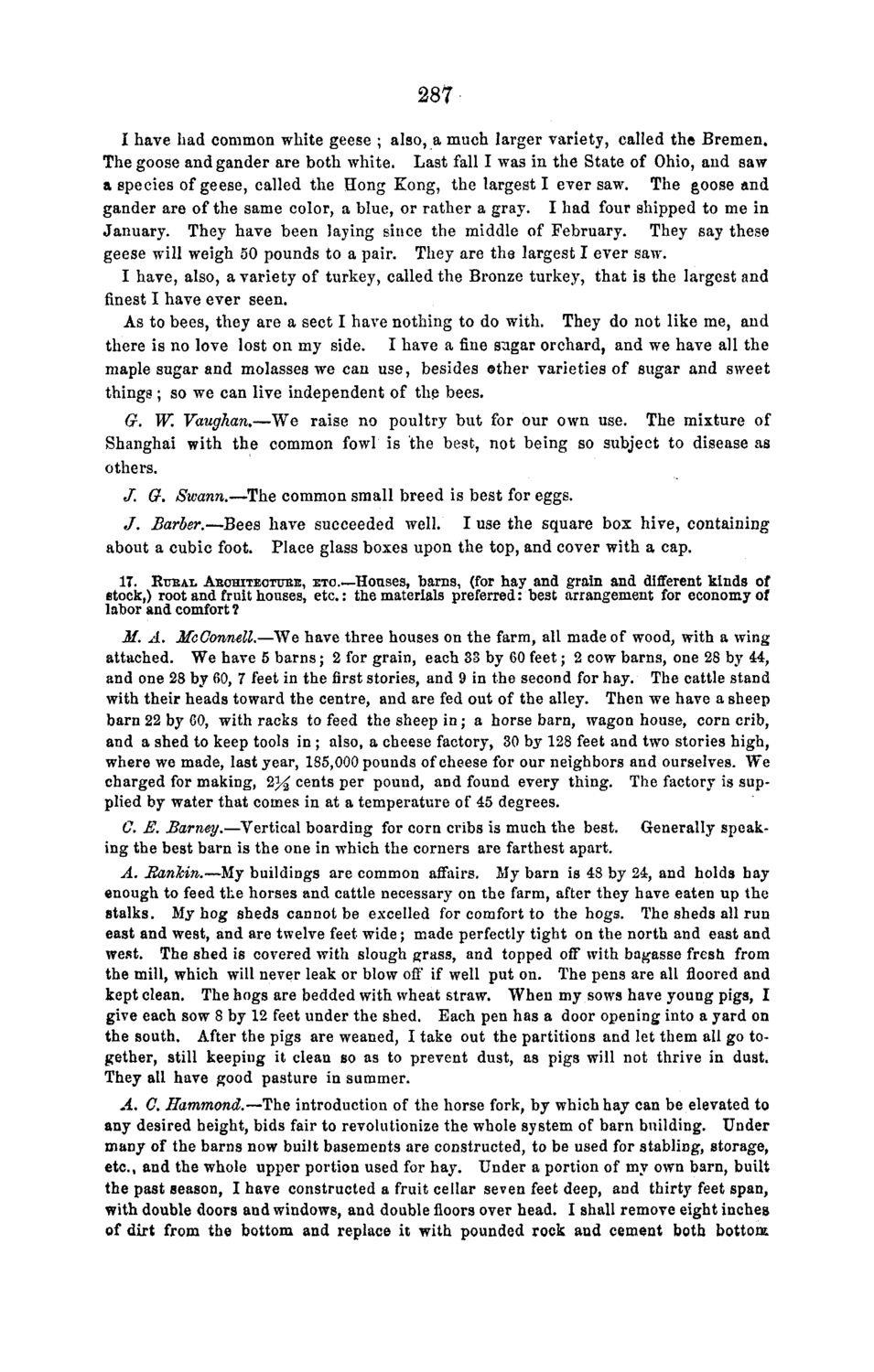| |
| |
Caption: Board of Trustees Minutes - 1868
This is a reduced-resolution page image for fast online browsing.

EXTRACTED TEXT FROM PAGE:
287I have had common white geese ; also, a much larger variety, called the Bremen. The goose and gander are both white. Last fall I was in the State of Ohio, and saw a species of geese, called the Hong Eong, the largest I ever saw. The goose and gander are of the same color, a blue, or rather a gray. I had four shipped to me in January. They have been lajing since the middle of February. They say these geese will weigh 50 pounds to a pair. They are the largest I ever saw. I have, also, a variety of turkey, called the Bronze turkey, that is the largest and finest I have ever seen. As to bees, they are a sect I have nothing to do with. They do not like me, and there is no love lost on my side. I have a fine sugar orchard, and we have all the maple sugar and molasses we can use, besides ©ther varieties of sugar and sweet things ; so we can live independent of the bees. G. W. Vaughan.—We raise no poultry but for our own use. The mixture of Shanghai with the common fowl is the best, not being so subject to disease as others. J. Q. Swann.—The common small breed is best for eggs. J. Barber.—Bees have succeeded well. I use the square box hive, containing about a cubic foot. Place glass boxes upon the top, and cover with a cap. IT. RTTEAL AEOHTTEOTTTEE, ETC.—Houses, barns, (for hay and grain and different kinds of etock,) root and fruit houses, etc.: the materials preferred: best arrangement for economy of labor and comfort ? M. A. McConnell.—We have three houses on the farm, all made of wood, with a wing attached. We have 5 barns; 2 for grain, each 33 by 60 feet; 2 cow barns, one 28 by 44, and one 28 by 60, 7 feet in the first stories, and 9 in the second for hay. The cattle stand with their heads toward the centre, and are fed out of the alley. Then we have a sheep barn 22 by 60, with racks to feed the sheep in; a horse barn, wagon house, corn crib, and a shed to keep tools in ; also, a cheese factory, 30 by 128 feet and two stories high, where we made, last year, 185,000 pounds of cheese for our neighbors and ourselves. We charged for making, 2% cents per pound, and found every thing. The factory is supplied by water that comes in at a temperature of 45 degrees. G. E. Barney.—Vertical boarding for corn cribs is much the best. Generally speaking the best barn is the one in which the corners are farthest apart. A. Rankin.—My buildings are common affairs. My barn is 48 by 24, and holds hay enough to feed the horses and cattle necessary on the farm, after they have eaten up the stalks. My hog sheds cannot be excelled for comfort to the hogs. The sheds all run east and west, and are twelve feet wide; made perfectly tight on the north and east and west. The shed is covered with slough grass, and topped off with bagasse fresh from the mill, which will never leak or blow of if well put on. The pens are all floored and f* kept clean. The hogs are bedded with wheat straw. When my sows have young pigs, I give each sow 8 by 12 feet under the shed. Each pen has a door opening into a yard on the south. After the pigs are weaned, I take out the partitions and let them all go together, still keeping it clean so as to prevent dust, as pigs will not thrive in dust. They all have good pasture in summer. A. C. Hammond.—The introduction of the horse fork, by which hay can be elevated to any desired height, bids fair to revolutionize the whole system of barn building. Under many of the barns now built basements are constructed, to be used for stabling, storage, etc., and the whole upper portion used for hay. Under a portion of my own barn, built the past season, I have constructed a fruit cellar seven feet deep, and thirty feet span, with double doors and windows, and double floors over head. I shall remove eight inches of dirt from the bottom and replace it with pounded rock and cement both bottom
| |